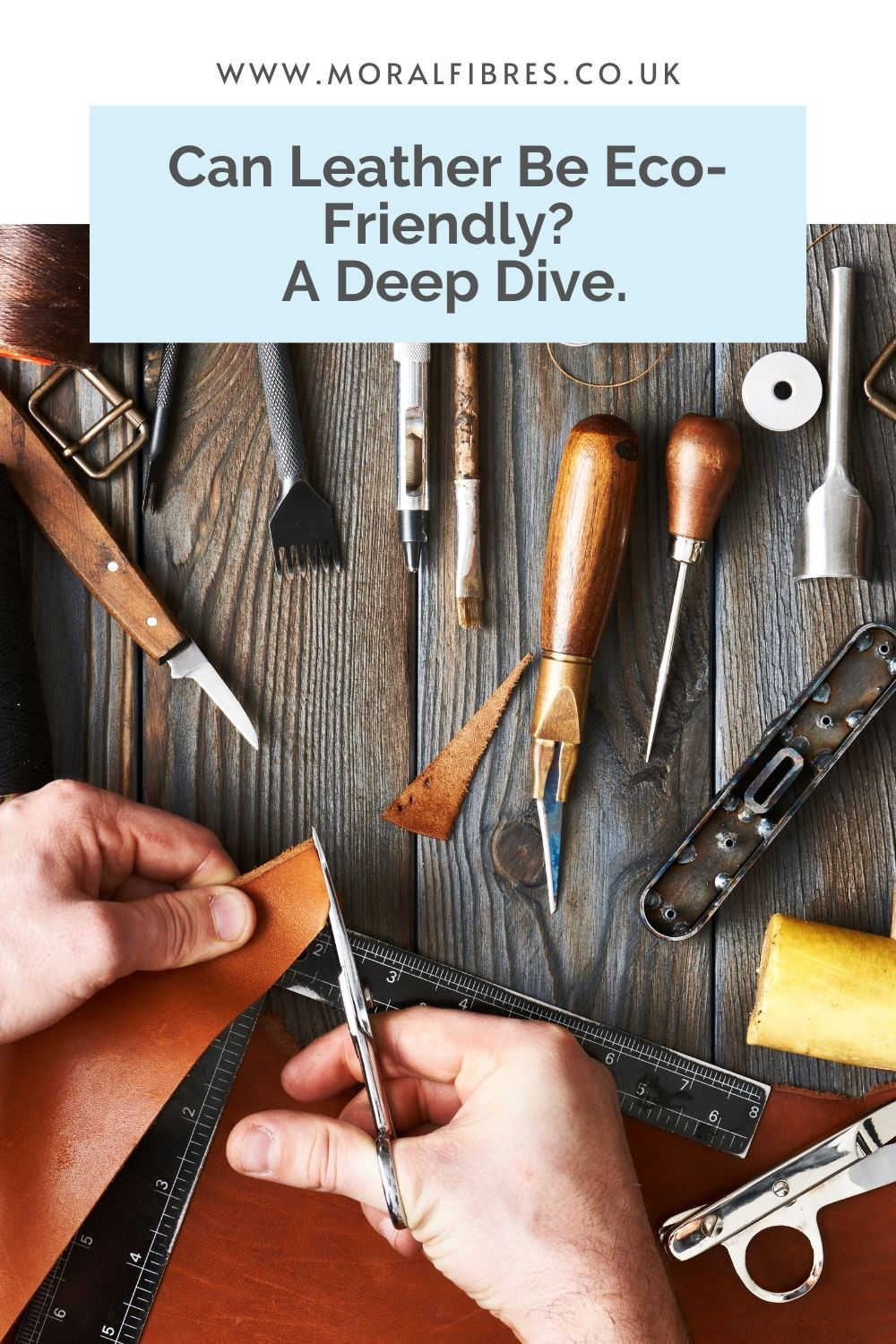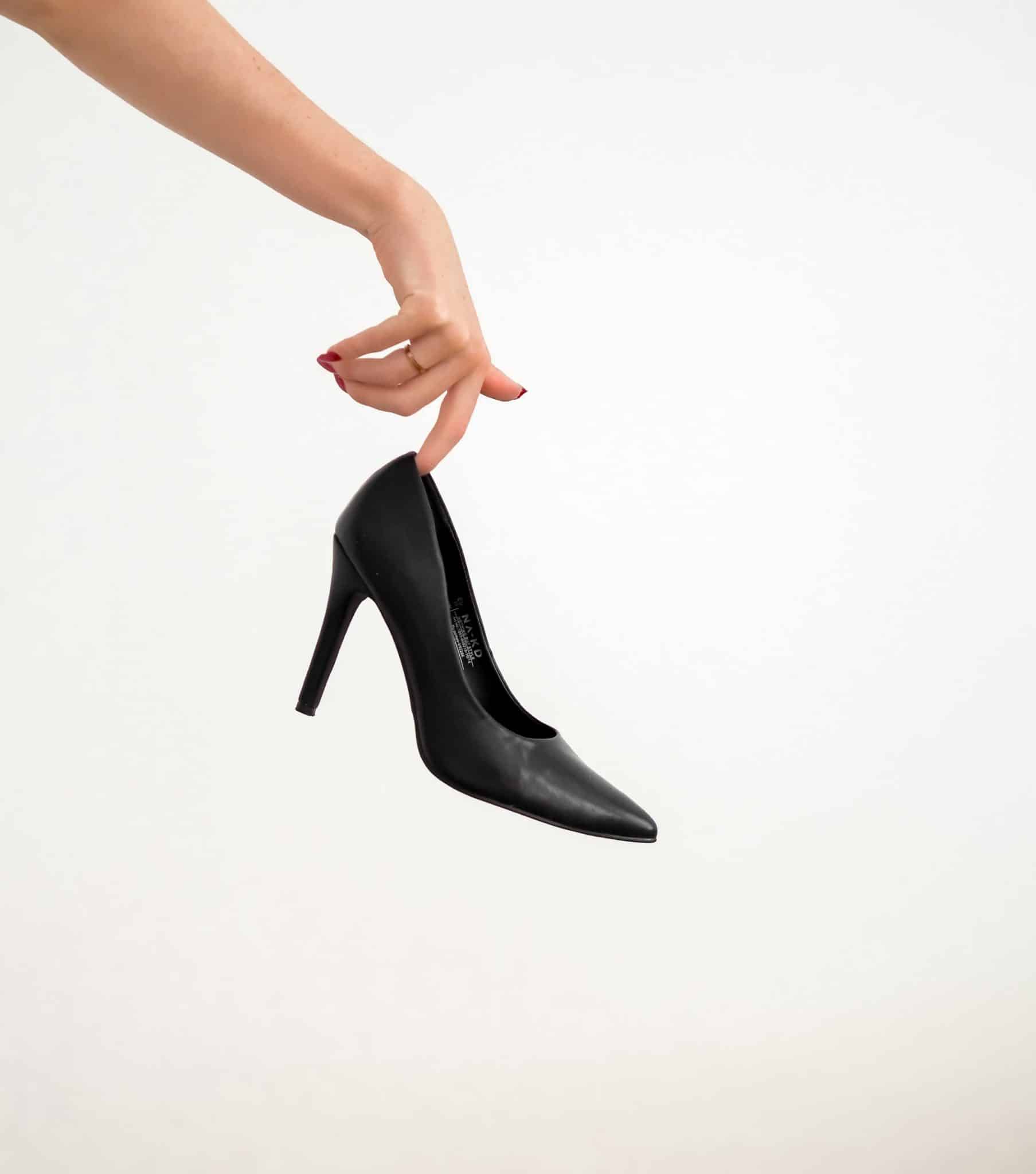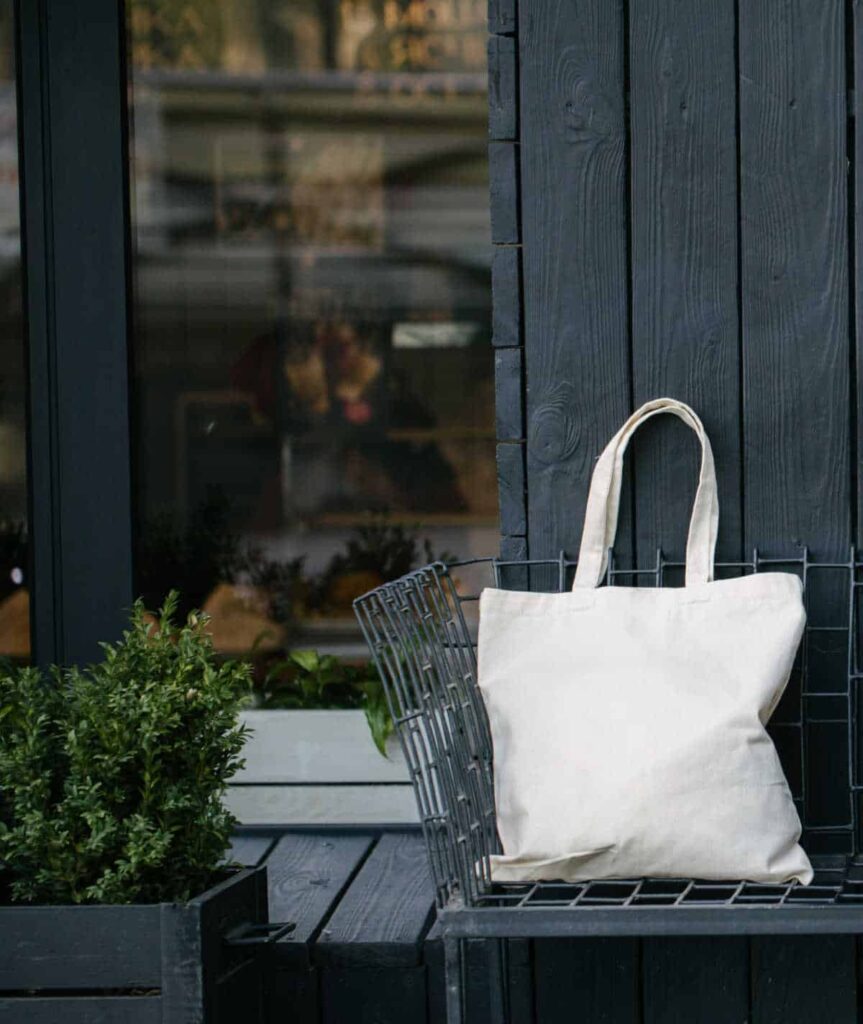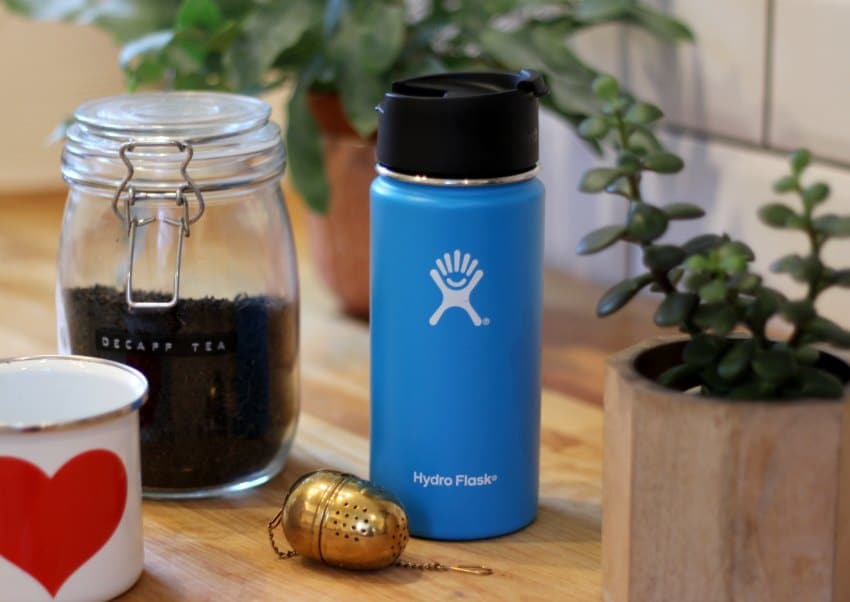Can Leather Be Eco-Friendly? A Deep Dive Into The Industry
To support the running costs of Moral Fibres, this post may contain affiliate links. This means Moral Fibres may earn a small commission, at no extra cost to readers, on items purchased through these links.
What are your thoughts on leather? Can leather be eco-friendly? And how eco-friendly are alternatives to leather? Let’s take a deeper look.
We do buy leather, but most of the leather in our house and wardrobe is second-hand. For quite a long time now I’ve been having an internal debate as to how eco-friendly leather is compared to its vegan polyvinyl chloride (PVC) and polyurethane (PU) counterparts. These are the main materials that “fake leather” or “pleather” are made from.
I’ve also had a few discussions with people about leather lately. Therefore, I thought it would be a good time to open up a good old-fashioned debate on leather vs. non-leather alternatives and seek an answer to the is leather eco-friendly question.
Is Leather Eco-Friendly?

Intensive animal rearing for leather has major environmental and ethical implications. This includes large-scale deforestation, increased methane levels, and animal cruelty issues.
Creating leather is resource-intensive, in terms of water and energy usage. Eco-friendly it isn’t. And it’s also no secret that the leather industry is hazardous to the environment, to workers, and local people’s health. This is due to the toxic heavy metal chemicals used in the tanning process, such as chromium. Chromium can cause cancer, and pollute waterways and soil, especially in India and China, where many tanneries go unregulated. Approximately 85-90% of the leather we buy is chromium treated.
What About Naturally Dyed Leather?
Other tanneries use traditional natural dyes in the tanning process, such as saffron, in place of chromium. This vegetable tanning takes much longer than chromium tanning. This means you do pay a premium. However, fewer harsh chemicals are involved, meaning less harm is caused to the environment and the tannery workers.
Vegetable-tanned leather is also easier and safer to recycle or dispose of. However, this more environmentally sensitive way of making leather does not take away the fact that animals are being killed to produce it.
Is Leather Not A By-product of The Meat Industry?
Leather is widely claimed by manufacturers as a by-product of the meat industry. As leather commands a higher cost than meat, I’m simply not convinced that leather is in fact a by-product of the meat industry.
I wonder if instead, could it be that meat is a by-product of the leather industry? According to PETA, a high proportion of leather sold in the UK comes from India. Yet according to reports, 24% of people in India are vegetarian. It’s certainly food for thought.
We can’t look at that fact in isolation though. 90% of the leather we import from Asia is bovine. And in the last couple of years, India has become the biggest beef exporter in the world, overtaking Brazil. Perhaps there is some truth to the matter, but it’s such a grey area.

If An Animal Is Killed For Its Meat, Shouldn’t We Use All Parts of The Animal?
Some people say that as long as there are people in the world willing to eat meat (currently 6% of the UK’s population is vegetarian) then there will always be animal by-products, such as leather.
Whilst I agree that when an animal is killed to be eaten then all parts of the animal should be used for something, even its skin, does this become an excuse to justify the need for leather? Or is it simply being pragmatic?
Are Alternatives to Leather Eco-Friendly?
Let’s look at whether leather alternatives are more eco-friendly than leather.
Do PVC and PU Contribute to Climate Change?
Although irrefutably more ethical when it comes to animal welfare, the production of PVC and PU faux leather requires petrochemicals derived from non-renewable fossil fuels, such as coal or natural gas.
Of course, raising cattle contributes to climate change, through methane associated with intensive cattle rearing. Meanwhile, PU and PVC may shed microplastic, which harms animals and humans. Again, it’s not a clear-cut issue.
How Toxic Is PU or PVC?
The chemicals themselves required to make PVC and PU leather alternatives aren’t eco-friendly, nor are they good for human health. PVC is regarded as the most toxic of all plastics. As well as being a known human carcinogen, it’s known to cause diabetes, as well as damage immune systems, disrupt hormones, and create birth defects. PVC’s effects are wide-ranging. Workers, soil and water supplies, and nearby communities can all be at risk.
PU is a slightly more eco-friendly choice than PVC when it comes to leather alternatives. Although chemical-laden, it requires fewer chemicals than PVC to produce. Although it is still toxic, particularly in the workplace, it is less toxic than PVC. Manufacturers are also now able to make PU with plant-based raw materials. This reduces the toxic chemical load in it, making it safer.
Is PU A Better Choice Than Leather?
Asking if PU is a better choice than leather opens up another eco-friendly dilemma. I have two vintage (+40-year-old) leather bags. I have used these on steady rotation for the past fifteen years. Both are still going strong. A little scuffed perhaps but it all adds to the character.
Comparing them to the cheap PU bag I owned before switching to those leather bags is night and day. I bought my PU bag new, and it barely lasted 6 months of near-daily use. The strap then stretched beyond repair and a hole developed in the bag itself. It ended up in the bin (to landfill, as it’s non-recyclable) less than a year after purchase. This leather alternative was not as eco-friendly as I had hoped it would be.
Which Option Is Best?
And herein lies the dilemma. Which option is the best? There are no easy answers to this one.

Other Eco-Friendly Alternatives to Leather and PU/PVC
One thing we can do is look at other eco-friendly alternatives to leather, and to PU and PVC.
Repair
The first alternative isn’t such an alternative, it’s more of a principle.
In the UK we import about £4 billion of leather fashion a year, predominantly shoes. At the same time, around 2 million shoes are dumped in landfills every year.
As per the ‘buyerachy of needs‘ (do check out the post if you haven’t seen it before), repairing what you already own is key. If you already own leather shoes, then instead of buying more shoes in alternative materials, the most eco-friendly option would be to re-sole shoes that you already own, if that’s possible. I’ve noticed a diminishing number of cobblers, possibly related to the fact that people are more likely to throw their shoes away when worn rather than pay £15-£20 to have a pair re-soled. Getting our shoes repaired helps support the repair economy.
Other Eco-Friendly Alternatives to Leather
If you’re looking to purchase alternatives to leather, or PU and PVC, then there are several different eco-friendly leather materials out there. These include:
- Cork leather – a vegan leather alternative made from the bark of the cork oak tree
- Barkcloth – a cotton fabric made from densely woven fibres
- eLeather – engineered leather which is made from discarded leather off-cuts that normally end up in landfill.
- Pinatex – a vegan leather made from pineapple
- Desserto – a vegan leather made from cactus
- Mushroom leather – made from, unsurprisingly, mushrooms
- AppleSkin – a vegan leather, made, from, you guessed it, apples
- Vegea – an eco-friendly vegan leather made from wine industry by-products
In many of these cases, it appears that plastic does have to be used to make these products. In the case of Pinatex for example, this is blended with as much as 50% plastic polyurethane, or at the least coated in plastic. As well as being made with fossil fuels, this means the fabric is not recyclable, compostable or biodegradable at the end of its life.
As you can see, it’s not as clear-cut as simply shifting from PU or PVC to leather made from apples or pineapples, for example. You do also have to ask if taking food products and diverting them to make clothing and accessories, diverts food from our tables, or displaces food production in poorer communities.
Conclusions
I personally think that the most environmentally and eco-friendly leather is the leather that you already own. Keeping them in active service, looking after them, and repairing your items as need be is the most environmentally friendly thing we can do.
Consuming less is another key part of this debate. And I think that when we need to buy new leather or fake leather products, looking to buy secondhand should always be a top priority.
And If you can’t buy secondhand, and must buy leather, then vegetable-tanned leather that has been produced ethically is one option. However, with the proliferation of new vegan leathers, such as Pinatex, then there are perhaps slightly more environmentally friendly ways to shop for vegan leather that may be less harmful to the environment than pure PU and PVC. I’ve got loads of suggestions in my guide to ethical shoes and my guide to ethical vegan shoes.
I’d love to hear your views on the eco-friendly leather debate too. Do share in the comments below.
Found this post useful? Please consider buying me a virtual coffee to help support the site’s running costs.





As a life-long vegetarian and a sustainable fashion advocate I have thought a lot about these issues. Personally I feel that vege-tanned leather is the most sustainable option. It is a natural material that when vege-tanned does not result in significant pollution in the environment. The industrial livestock industry does create significant environmental damage, but the impact one pair of vege-tanned shoes would be far less than the impact of a vegan leather pair. And that’s without even considering that leather shoes will greatly outlast vegan leather alternatives, meaning you should be comparing the impact of several vegan shoes with one leather pair.
As a vegetarian I’d prefer not to use leather, but when the bulk of our population eats meat, I am comfortable with owning a few pairs of well worn leather shoes and one or two well-cared-for leather handbags. As the previous commenter mentioned, these items will long outlast their non-leather counterparts. My pair of black leather Oxfords have been my main shoes (as in a wear them 90% of the time for 8 months of the year) for 4 years now, and have been repaired twice in that time, and they still come up as good as new.
Other than buying new, I always look at for second hand leather goods, but second hand shoes that I like are hard to find in my size. However, second hand leather jackets are great for crafting- in fact I plan to make myself a leather clutch from a second hand jacket I picked up for $10.
I prefer leather, for all the reasons you described above. My leather goods last for years and years, while the vegan goods–which cost as much as leather!–start losing rivets and the coating after just a few months. Lately, however, I’ve been asking before I buy, “Is this vegetable tanned?” That is important to me!